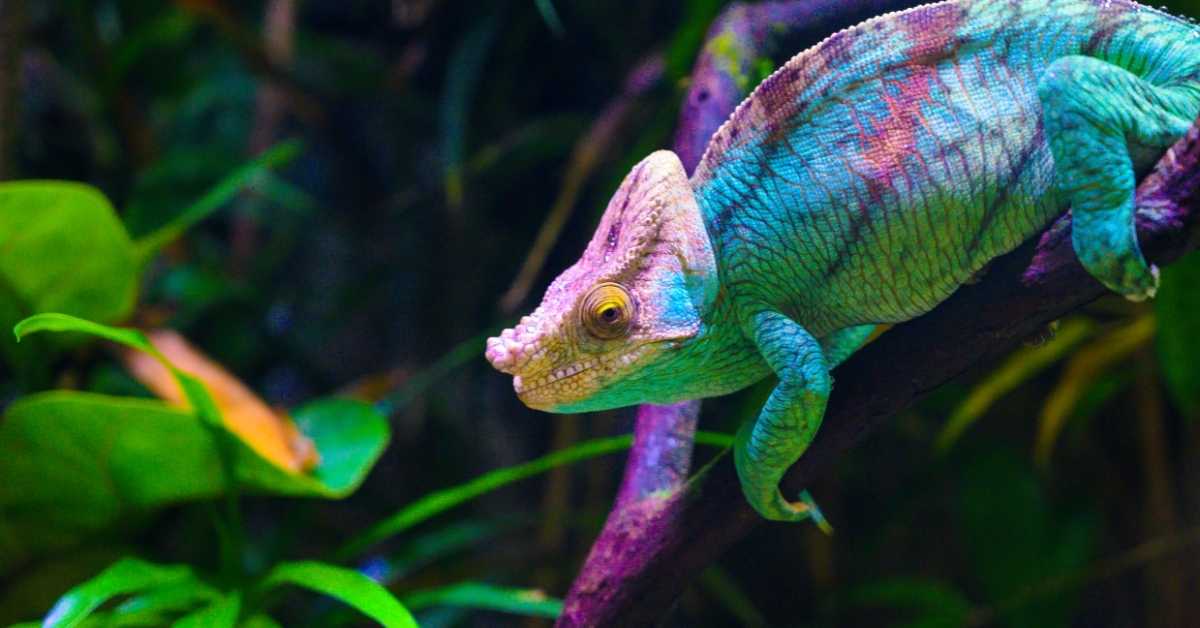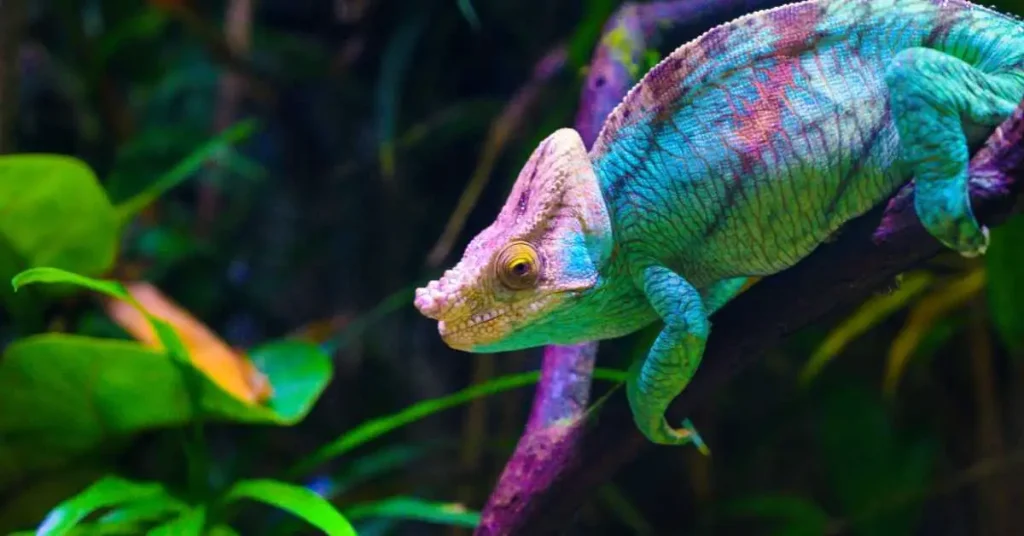Chameleons are fascinating creatures and have been the subject of many debates and discussions among animal enthusiasts. One of the most common questions asked about chameleons is whether they are cold-blooded or not. This question is often asked because many people assume that all reptiles are cold-blooded, but is that really the case with chameleons?
In this article, we will explore the topic of whether chameleons are cold-blooded or not. We will delve into the science behind cold-blooded and warm-blooded animals and examine the characteristics and behaviors of chameleons to determine which category they fall into. So, if you’re curious about chameleons and their unique adaptations, keep reading to find out more!

Are Chameleons Cold Blooded?
Chameleons are one of the most fascinating creatures in the animal kingdom. Known for their ability to change colors, they are often the subject of scientific studies and research. One of the most common questions asked about chameleons is whether they are cold-blooded or not. In this article, we will explore the answer to this question and provide you with all the information you need to know about chameleons.
What are Cold-blooded Animals?
Cold-blooded animals, also known as ectothermic animals, are those whose body temperature is regulated by their environment. Unlike warm-blooded animals, such as mammals and birds, who can maintain a constant body temperature, cold-blooded animals cannot. They rely on external sources of heat to maintain their body temperature, which is why they are often found basking in the sun.
Chameleons are classified as cold-blooded animals, which means that their body temperature fluctuates with the temperature of their surroundings. This is why you will often see chameleons basking in the sun to warm up their bodies. However, even though they are cold-blooded, they are still able to regulate their body temperature to some extent.
How Do Chameleons Regulate Their Body Temperature?
Chameleons have a unique ability to regulate their body temperature through behavior and physiology. They are able to control their body temperature by moving to different areas with varying temperatures, adjusting their posture to absorb or reflect sunlight, and changing the color of their skin to either absorb or reflect sunlight.
Chameleons also have a specialized circulatory system that helps them regulate their body temperature. Their blood vessels are arranged in a way that allows them to control the flow of blood to different parts of their body. This helps them to conserve or dissipate heat as needed.
The Benefits of Being Cold-blooded
Being cold-blooded has its advantages. For one, cold-blooded animals require less food than warm-blooded animals. This is because they do not need to use energy to maintain a constant body temperature. Cold-blooded animals are also able to survive in environments that would be too harsh for warm-blooded animals, such as deserts and arctic regions.
Another benefit of being cold-blooded is that it allows animals like chameleons to be more flexible in their behavior. Because they do not need to spend as much time and energy regulating their body temperature, they have more time to devote to other activities, such as hunting and mating.
The Drawbacks of Being Cold-blooded
While being cold-blooded has its benefits, it also has its drawbacks. One of the biggest drawbacks is that cold-blooded animals are less active in cooler temperatures. This means that during periods of cold weather, chameleons will not be as active and may even become sluggish.
Another drawback of being cold-blooded is that it makes animals like chameleons more vulnerable to predators. Because they are less active in cooler temperatures, they are easier targets for predators who are also more active in these conditions.
Chameleons vs Warm-blooded Animals
When it comes to chameleons versus warm-blooded animals, there are some key differences. Warm-blooded animals are able to maintain a constant body temperature, which means they are active all the time. They are also able to survive in a wider range of environments than cold-blooded animals.
On the other hand, chameleons are able to survive in environments that would be too harsh for warm-blooded animals. They are also able to regulate their body temperature more efficiently, which allows them to be more flexible in their behavior.
Conclusion
In conclusion, chameleons are cold-blooded animals that are able to regulate their body temperature through behavior and physiology. Being cold-blooded has its benefits and drawbacks, but it is a key adaptation that has allowed chameleons to survive in a wide range of environments. Whether you are a scientist studying chameleons or simply a curious animal lover, understanding their unique physiology is fascinating and important.
Frequently Asked Questions
Are Chameleons Cold Blooded?
Yes, chameleons are cold-blooded reptiles. This means that their body temperature is regulated by the environment around them, rather than internally like warm-blooded mammals. Chameleons need to bask in the sun to warm up their bodies and become more active.
However, chameleons are able to regulate their body temperature to a certain extent by changing their color. Dark colors absorb more heat, so if a chameleon wants to warm up, it may change to a darker color and bask in the sun. On the other hand, if a chameleon wants to cool down, it may change to a lighter color to reflect more heat.
What is the Optimal Temperature Range for Chameleons?
Chameleons come from warm climates and thrive in temperatures ranging from 75-85°F during the day and 65-75°F at night. It’s important to provide a temperature gradient in their enclosure so they can regulate their body temperature as needed. This can be achieved by using heat lamps or ceramic heat emitters.
However, it’s important to note that different species of chameleons have slightly different temperature requirements. It’s always best to research the specific species you plan on keeping to ensure that you provide the optimal temperature range.
Do Chameleons Hibernate?
Some species of chameleons may go through a period of reduced activity during cooler months, but they do not hibernate in the traditional sense. Instead, they may become less active or eat less during this time. It’s important to continue providing food, water, and proper temperatures during this time to ensure your chameleon stays healthy.
If you’re unsure if your chameleon is going through a period of reduced activity or if they’re sick, it’s best to consult with a veterinarian who specializes in reptiles.
How Often Should I Feed my Chameleon?
The frequency of feedings will depend on the age and species of your chameleon. Generally, juvenile chameleons will need to be fed more frequently than adults. Most chameleons will eat every day or every other day.
It’s important to provide a variety of food items to ensure your chameleon gets all the necessary nutrients. Feeder insects such as crickets, dubia roaches, and black soldier fly larvae are great options. It’s also important to dust the insects with calcium and vitamin supplements to prevent nutritional deficiencies.
Can Chameleons Swim?
While chameleons are not aquatic animals, they are capable of swimming if necessary. However, it’s important to note that not all chameleons are good swimmers and some may struggle in water. Additionally, it’s important to ensure that any water source in their enclosure is shallow and easily accessible to prevent drowning.
If you plan on providing a water source for your chameleon, it’s important to monitor them closely to ensure they are safe and comfortable.
There’s No Such Thing As “Warm-” Or “Cold-” Blooded
In conclusion, chameleons are most definitely cold-blooded creatures. Their body temperature is regulated by the temperature of their environment, which makes them unable to regulate their own body temperature. This can have a significant impact on their behavior and physiology.
Despite their cold-blooded nature, chameleons are fascinating creatures. Their ability to change color to match their surroundings is just one of the many unique traits that make them so intriguing. They are also known for their long, sticky tongues, which they use to catch insects.
Overall, chameleons are a remarkable species that continue to captivate scientists and nature enthusiasts alike. While their cold-blooded nature may be a disadvantage in some ways, it is also what makes them so unique and fascinating to study.


